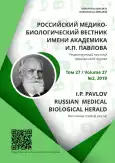General non-specific reactivity of an organism as a factor of individualization of de-mands, behavior and social activity of individual
- Authors: Mulik A.B.1, Ulesikova I.V.2, Mulik I.G.3, Bulatetsky S.V.4, Shatyr Y.A.5
-
Affiliations:
- Institute of Toxicology of Federal Medical-Biological Agency
- S.M. Kirov Military Medical Academy
- Volgograd State Agrarian University
- V.Y. Kikot Moscow University of the Ministry of Internal Affairs of the Russian Federation (Ryazan branch)
- Volgograd State University
- Issue: Vol 27, No 2 (2019)
- Pages: 227-236
- Section: Original study
- URL: https://journals.rcsi.science/pavlovj/article/view/14547
- DOI: https://doi.org/10.23888/PAVLOVJ2019272227-236
- ID: 14547
Cite item
Abstract
Behavioral and social activity, being a component of the general human activity, depends on a number of individual combinations of genotype and phenotype, as well as on environmental conditions. With sufficient elaboration of the general aspects of the physiological mechanisms, systemic organization of the behavioral and social activity of an individual remains an open question of the objective conditionality of the expression and orientation of social activity by individual combination of actualized demands and the psycho-physiological preconditions for their formation.
Aim. To identify regularities of physiological individualization of formation of demands, of behavioral and social human activity.
Materials and Methods. The research was carried out with the participation of 78 men and women aged 18-22 years, students of the Crimean Federal University.
Results. As a result of a complex of experimental studies, the systemic organization of functional, psychophysiological, psychological and social mechanisms of the individual organization of behavioral and social activity of an individual was confirmed. It is determined that anxiety, neuropsychological reactivity, extraversion and neuroticism, as the main preсonditions for behavioral and social activity, are most pronounced in individuals characterized by a high level of general nonspecific reactivity of an organism. The role of the functional and psychophysiological status of the organism in the individualization of demands is substantiated. At the same time, the minimal intensity of actualization of basic demands is characteristic of individuals with a low level of general nonspecific reactivity of an organism. Connections between individual vectors of social activity and basic human demands are specified. The most significant, universal impact on various types of social activity is produced by safety demands, which are the basic human biological demands. The demands for self-realization determine behavioral, social, professional and economic activity of a person. Social and cognitive demands positively affect behavioral and social activity. An insignificant negative relationship is revealed between reproductive demands and social destructiveness.
Conclusion. The cumulative registration of physiological and psychological characteristics provides an opportunity to predict the extent and subject orientation of the individual social activity.
Full Text
##article.viewOnOriginalSite##About the authors
Alexander B. Mulik
Institute of Toxicology of Federal Medical-Biological Agency
Author for correspondence.
Email: mulikab@mail.ru
ORCID iD: 0000-0001-6472-839X
SPIN-code: 8079-9698
ResearcherId: U-2142-2017
PhD in Biological Sciences, Professor, Leading Researcher
Russian Federation, Saint-PetersburgIrina V. Ulesikova
S.M. Kirov Military Medical Academy
Email: vestnik@rzgmu.ru
ORCID iD: 0000-0001-9284-3280
SPIN-code: 9859-6036
ResearcherId: D-3502-2016
Lecturer of the Department of Normal Physiology
Russian Federation, Saint-PetersburgIrina G. Mulik
Volgograd State Agrarian University
Email: vestnik@rzgmu.ru
ORCID iD: 0000-0002-8452-7306
SPIN-code: 5052-6472
ResearcherId: U-1853-2017
Senior Lecturer of the Department of Pedagogy and Methods of Vocational Training
Russian Federation, VolgogradSergey V. Bulatetsky
V.Y. Kikot Moscow University of the Ministry of Internal Affairs of the Russian Federation (Ryazan branch)
Email: vestnik@rzgmu.ru
ORCID iD: 0000-0002-6023-7523
SPIN-code: 2756-9179
ResearcherId: S-1631-2016
MD, PhD, Professor of the Department of Criminal Procedure and Criminology
Russian Federation, RyazanYulia A. Shatyr
Volgograd State University
Email: vestnik@rzgmu.ru
ORCID iD: 0000-0001-9279-5282
SPIN-code: 2942-6250
ResearcherId: U-2181-2017
PhD in Biological Sciences, Associate Professor, Senior Researcher of the Laboratory of Psychophysiology
Russian Federation, VolgogradReferences
- Bukhanovskiy AO, Andreyev AS. Strukturno-dinamicheskaya iyerarkhiya pola cheloveka. Rostov-na-Donu: Feniks; 1993. (In Russ).
- Myers DG. Social Psychology. 7th ed. Saint-Petersburg: Prime-Euroznak; 2002. (In Russ).
- Il’in EP. Differentsial’naya psikhologiya muzhchiny i zhenshchiny. Saint-Petersburg: Peter; 2003. (In Russ).
- Maddan S, Walker JT, Miller JM. Does size really matter? A reexamination of Sheldon,s somatotipes and criminal behavior. The Social Science Journal. 2008;45(2):330-44. doi: 10.1016/j.soscij.2008.03.009
- Saklofske D, Eysenck HJ, Eysenck SBG, et al. Extraversion-Introversion. In: Encyclopedia of Human Behavior. 2012. P. 150-159. doi: 10.1016/B978-0-12-375000-6.00164-6
- Bayevskiy RM. Prognozirovaniye sostoyaniy na grani normy i patologii. Moscow: Meditsina; 1979. (In Russ).
- Pavlov IP. Dvadtsatiletniy opyt ob'yektivnogo izu-cheniya vysshey deyatel’nosti (povedeniya) zhi-votnykh. Moscow: Nauka; 1973. (In Russ).
- Egorova MS. Psikhologiya individual’nykh razlichiy. Moscow: Planeta detey; 1997. (In Russ).
- Bernshneyn NA. Fiziologiya dvizheniy i aktivnost’. Moscow: Nauka; 1990. (In Russ).
- Zhukov DA. Biologiya povedeniya: gumoral’nyye mekhanizmy. Saint-Petersburg: Rech’; 2007. (In Russ).
- Ravich-Shcherbo IV, Matyurina TM, Grigorenko EL. Psikhogenetika. Moscow: Aspekt Press; 2000. (In Russ).
- Mulik AB, Postnova MV, Mulik YA, et al. Ellaboration and efficative analysis of the qualitative and quantitative estimation of the human requirements. I.P. Pavlov Russian Medical Biological Herald. 2010;(4):52-61. (In Russ).
- Mulik A, Novochadov V, Bondarev A, et al. New insights into genotype-phenotype correlation in individuals with different level of general non-specific reactivity of an organism. Journal of Integrative Bioinformatics. 2016;13(4). doi:10.2390/ biecoll-jib-2016-95
- Mulik AB, Postnova MV, Mulik YuA. Uroven’ obshchey nespetsificheskoy reaktivnosti organizma cheloveka. Volgograd: Volgogradskoye nauchnoye izdatel’stvo; 2009. (In Russ).
- Kharlanova EM. Razvitiye sotsial’noy aktivnosti budushchikh spetsialistov: psikhologo-pedagogi-cheskiy aspekt. Chelyabinsk: CHGPU; 2009. (In Russ).
- Delaryu VV, Tambiyeva FA. Metodiki izucheniya lichnosti. Kislovodsk: RGU; 1998. (In Russ).
Supplementary files












